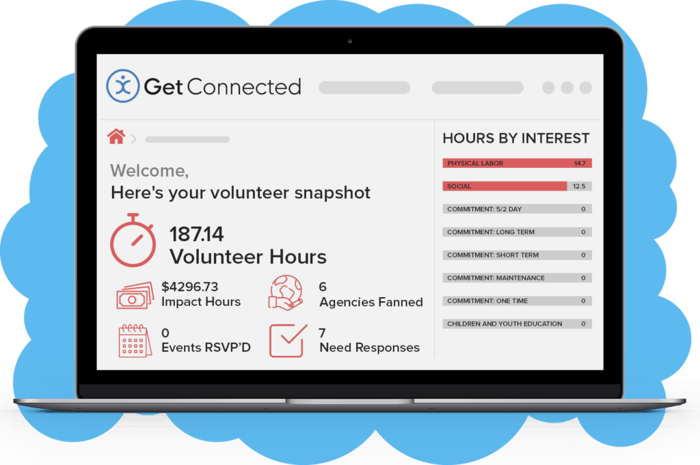You put lots of time and money into your volunteer program. But how can you ensure you’re getting the most from your investment? One of the best ways to measure your program’s financial effectiveness is to calculate your volunteer program ROI (Return on Investment).
In this article, we’ll discuss the how and why of calculating your volunteer program’s ROI. And because we’re talking about math, we also provide a free calculator to do it for you (phew!). On that note, a robust volunteer management software can simplify data collection, so the numbers you’ll need are always on hand.
Take these steps to measure (and improve) your volunteer program ROI to gain critical insights.
Article Contents

Volunteer Program ROI: The Basics
Businesses, nonprofits, and investors measure return on investment, or ROI, to justify costs and make more informed decisions about allocating resources.
First, let’s go back to basics:
What is a volunteer program?
A volunteer program is an organized strategy for recruiting and engaging volunteers to fulfill your mission. Starting a volunteer program is the first step for any organization that wants to take on volunteers.
Why is it important to invest in your volunteer program?
Maintaining a volunteer program requires an investment of resources, but time and money can yield an even greater return.
A sustainable volunteer program has numerous advantages to the organizations that host them. By growing your volunteer program, you can:
- Build capacity
- Increase donor engagement
- Maximize limited resources
- Direct community outcomes
- Strengthen community engagement
Why is it important to measure the impact of a volunteer program?
Tracking impact helps volunteer programs understand the value of its services. Volunteer programs can measure various impact metrics, like program output, goal progression, and anecdotal outcomes.
A volunteer program ROI calculation requires organizations to track volunteer time. Here’s why volunteer programs choose to measure impact using a variety of metrics, including ROI:
- Internal accountability – Encourage staff and volunteer commitment to your cause.
- Boost funding – Advocate for future financing and even secure more resources to expand programming.
- Facilitate growth – Collect the information you need to establish best practices and improve the quality of your services.
- Increase ROI – Measuring impact encourages organizations to put evaluation systems in place. Quantify outcomes to make a case for more investment in your program.
So what is ROI anyway? Let’s find out.
What is Volunteer Program ROI?
To understand ROI as it applies to volunteer programs, we’ll first explore the general concept of return on investment.
What is Return on Investment?
Return on Investment (ROI) is the ratio between the cost of an investment and the return on the money invested (also referred to as “net income” in the financial world). Organizations measure ROI to evaluate the performance or efficiency of an investment.
What is Volunteer Program ROI?
Are you getting more out of your volunteer program than what you’re putting in? Volunteer programs can measure the financial viability of their projects by measuring ROI.
While businesses and investors use net income to calculate the return, volunteer programs will weigh volunteer impact value to calculate its return on project spending.
Why should volunteer programs calculate ROI?
Your volunteer program ROI can give you a clue into the impact of your efforts. Volunteer programs track ROI to get a sense of:
- The real cost of running a volunteer program
- The cost of program inputs
- The value of program outputs
- The value of volunteers’ time
- Opportunities for improvement
Win stakeholders’ confidence by demonstrating that your program is well-managed and financially sound.

How to Measure your Volunteer Program ROI
There are several ways to measure your volunteer program ROI. Here, we outline a basic method and a more comprehensive method.
Why Choose the Basic Formula?
This formula allows you to calculate your ROI using data that is simpler to collect with the right tools and procedures in place.
The calculation compares the total cost of running your program (the investment) to the total volunteer of your volunteers’ time. Your result will yield a return. In theory, this dollar value is returned to the community in the form of a volunteer program’s services.
Why Choose the Comprehensive Method?
While the Basic Method for ROI calculation is reasonably easy to achieve, this Comprehensive Method requires you to collect more data.
Bear in mind that the time and effort you put into measuring your comprehensive ROI can provide you with a more accurate reading of your volunteer program’s value.
Let’s start by introducing the basic volunteer program ROI formula:
The Basic ROI Formula
The basic formula for Return on Investment is as follows:
Return On Investment = (Volunteer Value – Program Cost) / Program Cost
The above calculation will yield the Return on Investment per $1 of the program cost. In other words:
For every $1 invested in your program, x dollars were returned to the community.
Want to know your ROI percentage? Use this formula:
% ROI = [ (Volunteer Value – Program Cost) / Program Cost ] x 100
In the above formula, you’ll notice the term volunteer value. How do you get to that number? To calculate your volunteer program’s ROI, you’ll need to calculate the volunteer value:
How to Calculate Volunteer Value
We recommend you use the traditional method of determining volunteer value:
Volunteer Value = (Total # of Volunteer Hours) x (Estimated Volunteer Wage per Hour)
Many volunteer programs use either their state’s determined volunteer wage or the national average.
The Independent Sector establishes the current national volunteer wage value at $31.80 per hour.
In other words, for every hour an individual volunteers with your program, you are giving $27.20 back to the community.
Why quantify the value of the volunteer hour?
Their work impacts your outcomes, and their time has value, just as a paid employee’s time has value. Organizations must work to use volunteer time as effectively as possible.
Volunteer Value Calculation Example
Let’s illustrate the simple volunteer value formula:
Your volunteers contributed 10,000 hours last year. To calculate volunteer value, multiply 10,000 hours by the national volunteer wage ($27.20).
10,000 x $27.20 = $272,000
Therefore, your volunteers’ total time is worth $272,000.
It’s that simple!
Now we can input this value into the volunteer program ROI formula.
Sample ROI Calculation
Check out this example for calculating volunteer program ROI:
Let’s say a volunteer program spent $200,000 on the volunteer program for the year. The volunteer value for the year is $272,000. What is the volunteer program’s ROI?
- Total Program Cost: $200,000
- Total Volunteer Value: $272,000
Using these numbers, the formula will appear as follows:
(272,000 – 200,000) / 200,000 = $0.36
Therefore, for every $1 invested in your program, $1.36 was returned to the community.
Find your ROI percentage by multiplying the result (0.36) by 100:
ROI = 36%
The Comprehensive ROI Method
The comprehensive ROI method requires more data but results in a more detailed picture of your program’s investment.
While the basic ROI formula remains the same, we’ll take a different approach to calculate volunteer value.
Instead of using the value of volunteer time according to the national average, you will calculate the retail value of your volunteers’ services. You will also consider volunteer donations and in-kind donations to your return.
Here’s a reminder of the ROI formula:
ROI = (Volunteer Value – Program Cost) / Program Cost
How to Calculate Volunteer Value (Comprehensive Method)
Here is the formula for calculating Volunteer Value using the comprehensive method:
Volunteer Value = Total Retail Value of Service + Volunteer Donations
The Retail Value of Service requires programs to find the hourly local retail rate for a specific service provided. The value represents the amount of money you are saving your community when volunteers supply the service in lieu of a private provider.
To get the Retail Value of Service, you’ll need to track the following information:
- Type of Service Provided
- Volunteer Hours Logged
- Service Retail Rate per Hour
To find the Retail Value of Service, simply multiply Volunteer Hours logged by the Service Retail Rate (per hour):
Retail Value of Service = Volunteer Hours x Service Retail Rate
Below, we illustrate the calculation using this table of sample data:
|
Service Provided |
Volunteer Hours |
Service Retail Rate (per hour) |
Retail Value of Service |
|
Literacy Tutoring |
10,000 |
$28.50 |
$285,000 |
If your volunteers spent 10,000 hours tutoring over the year, you’ll want to know how much this service would have cost the community had they paid for a tutoring service or the total Retail Value of Service.
You can find the Service Retail Rate with a bit of research. Look for how much service providers are charging per hour in your community. Or consider referring to websites like Glassdoor, which can help you determine an average salary for a service in your area.
Note that if your program provides multiple services, your service retail rate may change. In that case, you’ll have to calculate the values for each service separately and add them together afterward.
Now that you have the total Retail Value of a Service, you can find the Volunteer Value. To do so, you’ll need to have the following additional data on hand:
- In-Kind Donations
- Volunteer Donations
We’ll use the sample data below to calculate Volunteer Value:
|
Service Provided |
Retail Volunteer Value of Service |
In-Kind Donations |
Volunteer Donations |
Total Volunteer Value |
|
Literacy Tutor |
$285,000 |
$5,000 |
$10,000 |
$300,000 |
To get the Total Volunteer Value, simply add the previous three columns.
Sample ROI Calculation (Comprehensive Method)
We now have all the numbers you need to calculate your volunteer program ROI using this comprehensive method. We’ll pull the data from the above example to calculate ROI for a sample volunteer program.
You’ll need these totals (over a consistent period):
- Program Cost: $200,000
- Volunteer Value: $300,000
Plug them into our handy formula:
(300,000 – 200,000) / 200,000 = $0.50
For every $1 invested in your program, $1.50 was returned to the community.
0.50 x 100 = 50% ROI
Understanding Your Results
An ROI calculation may result in either a positive ROI or a negative ROI.
A positive ROI indicates that you are getting more out of a program than you’re putting in. The output is greater than the cost—the greater the positive result, the larger your return on investment.
A negative ROI means your programs are costing you more than the value of your service. A negative result means you may have to reevaluate this program. You’ll want to look at the efficiency of your processes to reduce the spending deficit.
Keep in mind that starting a volunteer program may require more upfront costs. New programs are more likely to experience higher initial start-up costs. Once a project is up and running, with effective management, costs should decrease, and volunteer engagement increases.
Gathering Data for your Volunteer Program ROI
To calculate your volunteer program’s ROI, you’ll need to track a lot of data. Therefore, you’ll need a system in place to collect this data effectively. Key data includes program costs and volunteer hours.
Calculating Costs
To determine the investment, you’ll need to consider the following types of costs: monetary investment, time investment, and overall investment. Let’s define each of these terms:
- Monetary Investment Cost Data – Monetary investment is the amount of money spent on the volunteer program. Typically, volunteer program monetary costs take the form of three main categories:
-
- Physical resources (office space, supplies, and equipment)
- Personnel (building managers, contractors, and consultants)
- Engagement tools (marketing, advertisement, and volunteer management software)
- Time Investment Cost Data – Time investment is the amount of time that employees, staff, and board members invested in the volunteer program. Note that volunteer programs should only consider paid employee time as a cost. Volunteer time, on the other hand, is regarded as a return.
- Overall Investment = Total Cost – Your total costs are equal to the time and money costs of running your volunteer program. Simply add these costs together to get your overall volunteer program investment.
Examples of Volunteer Program Costs
What counts as a “cost”? Here are some examples of data to collect:
- Staff: Find the cost of staff time using their salary. Multiply each employee’s salary by the percentage of time spent on volunteer program-related activities.
- Office Overhead: Calculate office overhead based on the percentage of space dedicated specifically to your volunteer program.
- Training and Orientation: Costs associated with volunteer onboarding and training.
- Tools and Materials: Tools needed to complete volunteer activities, including transportation.
- Software and Advertising: Costs of volunteer management software and other marketing efforts.
Collecting Volunteer Value Data
Do you currently have a system in place to track volunteer hours? You’ll need to collect volunteer hours data to measure the value of your volunteers’ time.
Some organizations choose to use a volunteer hours log (follow the link for a complete guide, including volunteer hours log templates). In contrast, others prefer to invest in volunteer management software.
Volunteer management software can help automate hours tracking and even calculate the value of volunteer time, saving volunteer professionals time and money on complicated administration (and ultimately increasing your ROI!).

Improving Your Volunteer Program ROI
Now that you know how to measure your ROI, what do you do with your results?
First, examine these results in light of your organization’s mission; you’ll make better decisions about where to allocate resources. You may decide that you need to invest more in your volunteer management processes to increase your ROI.
One of the best ways to improve your ROI is to boost your operational efficiency. By becoming more efficient, you can reduce costs and improve the quality of your performance over time.
How can a volunteer program become more efficient?
A volunteer management software can not only help you track the data you need to measure ROI, but it will also alleviate the administrative backlog and streamline your volunteer management process.
How Volunteer Management Software Can Increase Your Program Impact
When best utilized, a multifaceted volunteer management software can help to improve volunteer ROI across the board:
Organization and Time-Saving
Time-saving tools like self-scheduling and automatic hours tracking allow volunteer coordinators to utilize their time better and redirect their efforts toward engaging volunteers and improving services. By decreasing employee time, you can increase ROI.
Reporting
Volunteer hours reporting can be one of your most valuable tools when measuring impact. Automated reporting will improve data accuracy and expand tracking capabilities.
Review impact data and program efficiency in real-time so that you can apply for the funding you need and continuously improve programming.
Recruitment, Engagement, and Retention
When you invest in a system that works for your organization, you’ll have the tools you need to recruit more volunteers and reduce turnover, increasing your ROI.

Your platform should simplify the registration process while providing an engaging database of searchable opportunities. Look for features that prioritize engagement, such as:
- Opportunity Matching: A robust system will target volunteer interests and skills to provide opportunity suggestions; volunteers are more likely to find an opportunity they’ll love. Make the most of each volunteer’s expertise while fostering better relationships.
- Simplified Communication: Access a volunteer database where coordinators can communicate with volunteers directly through the platform. Send email reminders, filter users, and engage volunteers with practical, tailored communication.
- Personalized Volunteer Dashboard: Volunteers like to know the work they’re doing matters. A platform that allows volunteers to track their efforts and view their impact in real-time encourages repeat volunteerism.
Convert Volunteers to Donors
Volunteers are twice as likely to donate to a cause as non-volunteers. When you retain your volunteers, they’re more likely to become supporters of your program. Donations will ultimately improve your ROI while supporting program costs.
Organizations invest in volunteer programs to get more in return. Smart investing will yield better, more sustainable outcomes.
For example, volunteer management software is a cost or investment, but when used productively, it can save you more time and improve efficiency, therefore increasing your overall ROI.
Including ROI measurement and reporting as part of your volunteer program practice will help you make the most of your volunteers’ time, have the most significant impact on your community, and ensure that your outputs are greater than your inputs.





